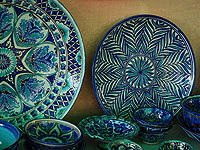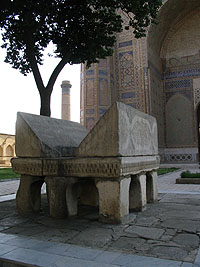 |
|
Uzbekistan - Milestones of History |
||||
|
The first millennium B.C. had become the time when ancient agricultural provinces of Uzbekistan began integrating with the world by qualitatively changing their social structures. And it was an important era for enriching their economic and cultural potential. In the 4th century B.C., the Empire of Alexander the Great came on the scene of the world history. In late 330 B.C. Alexander captured Bactria's capital, town of Bactri. However, Alexander's troops ran against fierce opposition on the part of the unified troops led by a talented Sogdian called Spitamen. Raging fierce attacks on the defense, Alexander managed to move forward further along the right bank of the Amu Darya and captured Samarkand, the capital of Sogdiana. The nomadic tribes are said to have supported the population of Bactria and Sogdiana against the Greek and Macedonian invaders by launching sudden raids that caused great damage to Alexander's troops. Following steadfast opposition on the part of the local masses, Alexander the Great had to look for support from the local aristocracy, as well as use various political tricks, and come to compromises. Partly, he was successful in doing that. In late 328 B.C., by way of grafting the local elite, military tricks, and betrayal, he succeeded to stifle the rebellion in Bactria and Sogdiana, leading to the death of Spitamen. However, the population in some captured towns and fortresses kept resisting the invasion, and Alexander sometimes had to recapture them by siege, as had been the case, for example, with Samarkand. In the summer of 327 B.C., he succeeded in reestablishing his nominal rule in Bactria and Sogdiana. The invasion brought tough ordeals, death and destruction to towns and settlements, which once prospered and lived their own life. The cruel and severe war with aggressors broke the economy as a whole, trade, and cultural life of Bactria, Sogdiana, and Khorezm. But at the same time, it should be underscored, that creation of the "world empire" by Alexander the Great in one way or another led to the prospering of trade and cultural relations between the countries that were the part of that empire. The war also brought Greek and Macedonian merchants. The recovery of Greek coins in Central Asia serves as a witness to active trade relations that existed in the region. Nevertheless, it did not last long. Following the death of Alexander in June 13,323 B.C., the local provinces of a once huge empire, moved along the path of gaining political independence. The second half of 3000 and 1000 B.C. the area where once stood the huge empire of Alexander the Great saw creation of many other big and small states with their own features of development, increase in trade, handicraft art, and renewed town planning. Thus, the Kushan Kingdom emerged as one of the powerful states in 1000 B.C. The peak of its rise the kingdom has seen late 1st century AD. - beg. 2nd century A.D., when it comprised of the territories of present day Northern India, Pakistan, Afghanistan, Tajikistan, and the southern provinces of Uzbekistan. Alongside Rome and Han empires, it turned into a world power. One of the most renowned rulers of the kingdom was Kanishka. His rule witnessed the competition of the kingdom with Han's China over Eastern Turkestan, through which vital trade routes used to pass along. Still, one of the significant events of the rule by Kanishka was a declaration of Bactrian language and writing as official in the kingdom. From that time on, writing on coins followed in Bactrian, but not in Greek or Indian languages. The town of Termez became one of the largest trade and cultural centers of the Kushan kingdom. Its territory was fortified with a powerful defense wall. Buddhist religious complexes were erected along the suburbs of towns such as Koratepa, Chingbiztepa, Fayoztepa, Zurmala, and others. Due to widespread practice of religious tolerance, the unique convergence of Hellenic, Indian, and nomadic cultures took place in both literary and material culture of the given epoch. Many samples, recovered from various settlements in the area, serve witness to the aforementioned. The period of the Kushan rule saw new economic development with more sown areas and irrigation canals. Handicraft work was further improved. |


